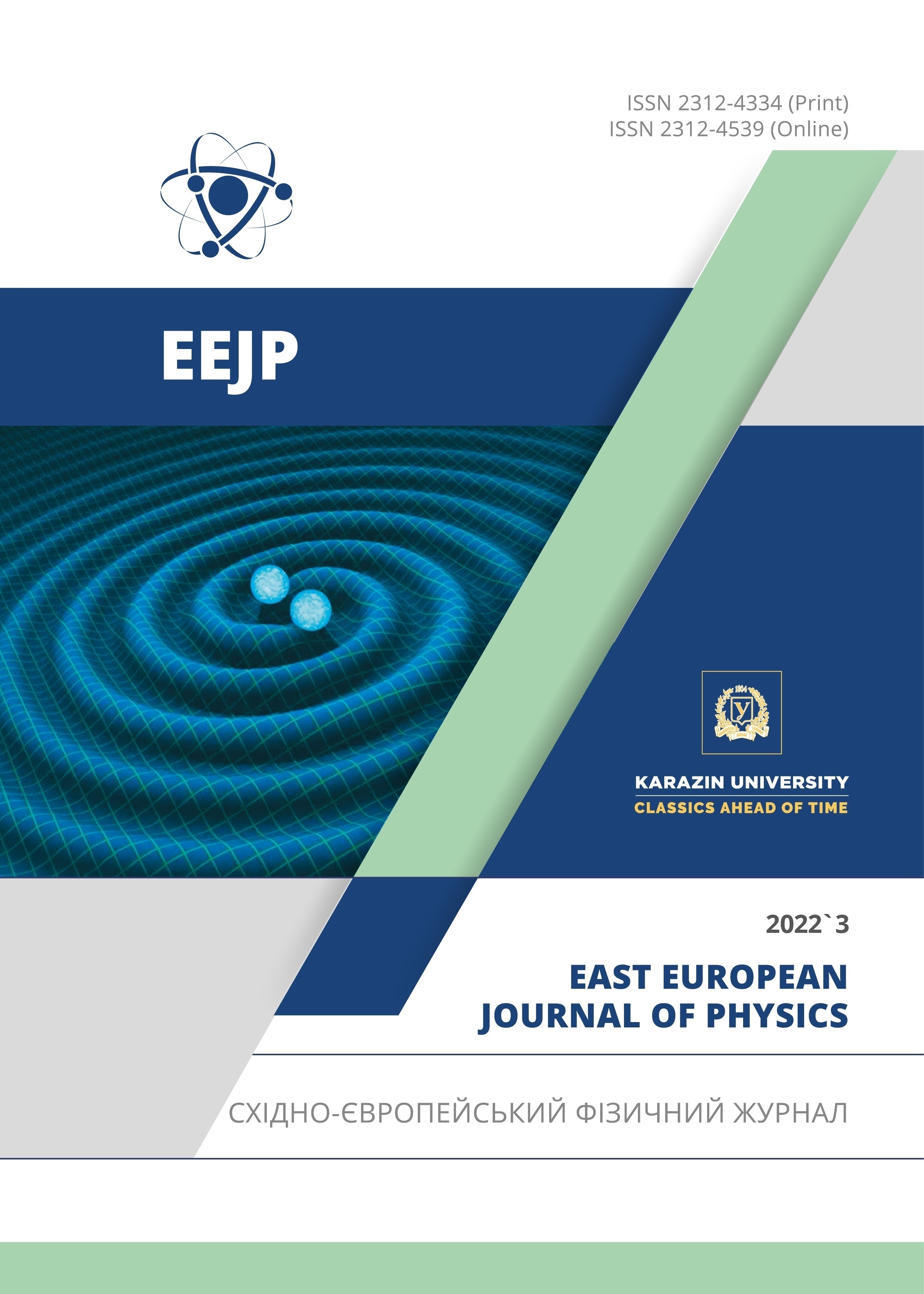Multiple Docking of Fluorescent Dyes to Fibrillar Insulin
Abstract
The co-localization of the donor and acceptor fluorophores capable of transferring the energy by the Fӧrster mechanism, on the molecular scaffold of amyloid fibrils offers new opportunities not only for refinement of the amyloid detection and structural analysis, but also for designing photonic nanodevices on their basis. The assembly of these systems involves the non-covalent dye-protein interactions which can hardly be characterized in terms of a precise dye location within the fibril structure that is required for fabricating the FRET-based light harvesting systems or photonic nanowires. In view of this, the dye-fibril binding process deserves a detailed in silico study. In the previous molecular docking studies of the FRET donors and acceptors interacting with the insulin model fibrils we considered only one ligand during the simulation procedure. However, the real situation is much more complicated, when the multiple ligands can compete for the same binding site, a direct complexation between the dyes on the fibril scaffold can take place, the spatial distribution of the bound fluorophores can be unfavorable for the energy transfer, etc. In addition, the mutual orientation of the donor and acceptor molecules essentially contribute to the efficiency of the Förster resonance energy transfer (FRET) in the investigated systems. The present study was undertaken to gain molecular docking insight into the binding of the donor (Thioflavin T) and acceptor (Congo Red or a phosphonium dye TDV) fluorophores to the insulin amyloid fibrils using the multiple docking approach. The employed PatcDock and SwissDock webserves provided evidence for the preferable association of all dyes with the fibril grooves. The protein-ligand interaction profiler (PLIP) was employed for analyzing the (InsF + ThT +CR) and (InsF + ThT + TDV) systems. The revealed binding modes and the types of the dye-fibril interactions may be of importance for a more detailed analysis of the FRET process in amyloid systems and may serve as a background for further in silico studies of the cascade FRET on the amyloid fibril scaffold.
Downloads
References
F. Chiti, and C.M. Dobson, Annu. Rev. Biochem. 75, 333 (2006), https://doi.org/10.1146/annurev.biochem.75.101304.123901
T.P. Knowles, and R. Mezzenga, Adv. Mater. 28, 6546 (2016), https://doi.org/10.1002/adma.201505961
W.E. Klunk, J. Histochem. Cytochem. 37, 1273 (1989), https://doi.org/10.1177/37.8.2666510
M.R.H. Krebs, E.H.C. Bromley, and A.M. Donald, J. Struct. Biol. 149, 30–37 (2005) https://doi.org/10.1016/j.jsb.2004.08.002
M. Groenning, J. Chem. Biol. 3, 1–18 (2010), https://doi.org/10.1007/s12154-009-0027-5
M. Girych, G. Gorbenko, I. Maliyov, V. Trusova, C. Mizuguchi, H. Saito, and P. Kinnunen, Methods Appl. Fluoresc. 4, 034010 (2016). https://doi.org/10.1088/2050-6120/4/3/034010
G. Gorbenko, V. Trusova, T. Deligeorgiev, N. Gadjev, C. Mizuguchi, and H. Saito, J. Mol. Liq. 294, 111675 (2019), https://doi.org/10.1016/j.molliq.2019.111675
U. Tarabara, M. Shchuka, K. Vus, O. Zhytniakivska, V. Trusova, G. Gorbenko, N. Gadjev, and T. Deligeorgiev, East Eur. J. Phys. 4, 58 (2019), https://doi.org/10.26565/2312-4334-2019-4-06
U. Tarabara, E. Kirilova, G. Kirilov, K. Vus, O. Zhytniakivska, V. Trusova, and G. Gorbenko, J. Mol. Liq. 324, 115102 (2021), https://doi.org/10.1016/j.molliq.2020.115102
G. Gorbenko, O. Zhytniakivska, K. Vus, U. Tarabara, and V. Trusova, Phys. Chem. Chem. Phys. 23, 14746 (2021), https://doi.org/10.1039/D1CP01359A
T. Lengauer, and M. Rarey, Curr. Opin. Struct. Biol. 6, 402 (1996), https://doi.org/10.1016/S0959-440X(96)80061-3
P.F. Leonhart, E. Spieler, R. Ligabue-Braun, and M. Dorn, Soft Comput. 23, 4155 (2019), https://doi.org/10.1007/s00500-018-3065-5
S.F. Sousa, P.A. Fernandes, and M.J. Ramos, PROTEINS: Structure, Function, and Bioinformatics, 65, 15 (2006), https://doi.org/10.1002/prot.21082
R. Huey, G.M. Morris, A.J. Olson, and D.S. Goodsell, J. Computational Chemistry, 28, 1145 (2007), https://doi.org/10.1002/jcc.20634
H. Li, PhD Thesis, (2012), https://etd.ohiolink.edu/
H. Li, and C. Li, J. Computational Chemistry, 31, 2014 (2010), https://doi.org/10.1002/jcc.21486
S. Raghavendra, S.J. Rao Aditya, Vadlapudi Kumar, and C.K. Ramesh, Computational Biology and Chemistry. 59, Part A, 81 (2015), https://doi.org/10.1016/j.compbiolchem.2015.09.008
P. Csizmadia, in: Proceedings of ECSOC-3, The Third International Electronic Conference on Synthetic Organic Chemistry, (MDPI, Basel, Switzerland, 1999), pp. 367-369. https://doi.org/10.3390/ecsoc-3-01775
M.D. Hanwell, D.E. Curtis, D.C. Lonie, T. Vandermeersch, E. Zurek, and G.R. Hutchison, J. Cheminform. 4, 17 (2012), https://doi.org/10.1186/1758-2946-4-17
A. Grosdidier, V. Zoete, and O. Michielin, Nucleic Acids Res. 39, W270 (2011), https://doi.org/10.1093/nar/gkr366
D. Schneidman-Duhovny, Y. Inbar, R. Nussinov, and H.J. Wolfson, Nucl. Acids. Res. 33, W363 (2005), https://doi.org/10.1093/nar/gki481
E.F. Pettersen, T.D. Goddard, C.C. Huang, G.S. Couch, D.M. Greenblatt, E.C. Meng, and T.E. Ferrin, J. Comput. Chem. 25, 1605 (2004), https://doi.org/10.1002/jcc.20084
M. Biancalana, and S. Koide, Biochim. Biophys. Acta, 1804, 1405 (2010), https://doi.org/10.1016/j.bbapap.2010.04.001
C. Wu, M. Biancalana, S. Koide, and J.E. Shea, J. Mol. Biol. 394, 627 (2009), https://doi.org/10.1016/j.jmb.2009.09.056
O. Zhytniakivska, A. Kurutos, U. Tarabara, K. Vus, V. Trusova, G. Gorbenko, N. Gadjev, and T. Deligeorgiev, J. Mol. Liq. 311, 113287 (2020) https://doi.org/10.1016/j.molliq.2020.113287
K. Vus, M. Girych, V. Trusova, G. Gorbenko, A. Kurutos, A. Vasilev, N. Gadjev, and T. Deligeorgiev, J. Mol. Liq. 276, 541 (2019), https://doi.org/10.1016/j.molliq.2018.11.149
M.I. Ivanova, S.A. Sievers, M.R. Sawaya, J.S. Wall, and D. Eisenberg, PNAS. 106, 18990–18995 (2009), https://doi.org/10.1073/pnas.0910080106
S. Forli, R. Huey, M.E. Pique, M. Sanner, D.S. Goodsell, and A.J. Olson, Nat. Protoc. 11, 905 (2016), https://doi.org/10.1038/nprot.2016.051
Copyright (c) 2022 Uliana Tarabara, Olga Zhytniakivska, Kateryna Vus, Valeriya Trusova, Galyna Gorbenko

This work is licensed under a Creative Commons Attribution 4.0 International License.
Authors who publish with this journal agree to the following terms:
- Authors retain copyright and grant the journal right of first publication with the work simultaneously licensed under a Creative Commons Attribution License that allows others to share the work with an acknowledgment of the work's authorship and initial publication in this journal.
- Authors are able to enter into separate, additional contractual arrangements for the non-exclusive distribution of the journal's published version of the work (e.g., post it to an institutional repository or publish it in a book), with an acknowledgment of its initial publication in this journal.
- Authors are permitted and encouraged to post their work online (e.g., in institutional repositories or on their website) prior to and during the submission process, as it can lead to productive exchanges, as well as earlier and greater citation of published work (See The Effect of Open Access).








